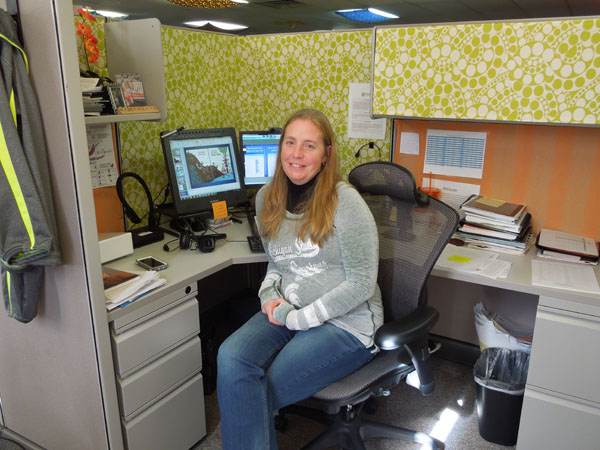In one tech-heavy cyber school, a low-tech strategy spurs learning
From her desk in Okemos, third-grade teacher Kim Roberts welcomes students with a smile and a wave, and describes a book they’re going to read together in class.
About 550 miles away, one of Roberts’s students, Keaton Maki, sits at a kitchen table in Ironwood, in the Upper Peninsula along the Wisconsin border. To his right is fifth-grade sister, Gabbi; to his left, first-grade sister, Brynn. All three work on school assignments for teachers they primarily know from the small images on their computer screens.
Sometimes, the three elementary-school-age kids peck away at laptops at the same table; other times, they head to different corners of the house for quiet studying or to put on headphones and take part in an interactive lesson with their teachers.
“It can be kind of crazy,” said mom Kim Maki. “But it works great for our family.”
The Maki children are among close to 1,700 students enrolled in the Michigan Connections Academy. The school is unusual because it’s one of a handful of so-called cyber schools in Michigan where students take all their classes online, interacting with their teachers primarily though emails, phone calls and the K-12 equivalent of webinars. The school is also unusual because, in a field where online schools frequently underperform compared with their brick-and-mortar peers, Michigan Connections students are performing well academically.
Michigan Connections students performed better than students at any other online elementary, middle and high school in Bridge Magazine’s 2014 Academic State Champs rankings, which compares schools across the state while factoring in the economic background of their students.
Michigan Connections’ high school scores ranked it 31st among all high schools in the state, putting it in the top 5 percent in Michigan; the charter’s score for elementary, middle and high school combined placed it in the top 26th percentile of all districts.
Online schools have been criticized by many education leaders in Michigan and nationally who argue students don’t learn as much sitting in front of a computer as they do in traditional classrooms. That criticism is somewhat borne out in a Bridge Magazine data analysis.
Those substandard results have fueled a continuing debate over the state’s decision in 2012 to greatly expand cyber charter schools even before the state had sufficient data to demonstrate the success of a pilot program ‒ a pilot of which Michigan Connections was a part.
While many of its peer virtual charter schools have struggled academically, Michigan Connections is succeeding, partly, its leaders say, because of a decidedly low-tech approach that includes close collaboration among teachers and consistent communication with parents.
More coverage: Two years later, jury still out on Michigan’s cyber school expansion
Headsets, computer monitors and kettle chips
Home base for the academy is tucked away in a low-slung building in a nondescript office park in Okemos, a suburb of Lansing. Inside are the “classrooms” – row after row of cubicles occupied by teachers with headsets, computer monitors, family photos and the occasional bag of snack food.
Online schools aren’t required to have a building to house their teachers, but it’s a model that Principal Bryan Klochack says pays dividends. While Michigan Connections teachers are allowed to work from home if they’re under the weather or the road conditions are poor, the office setting allows valuable collaboration.
Teachers can poke their heads above the adjoining cubicle wall when they need help with a student, rather than being “locked in their classrooms” all day, said third-grade teacher Roberts. Teachers in the same grade or subject don’t have to wait until after school hours or for a planning period to meet – they can simply roll chairs together or stand in a cubicle aisle.
“One of the neatest things is we’re able to have more in-depth conversations with our staff in terms of instructional leadership because we have (more flexible) schedules,” said Klochack. “We meet with our staff every three weeks, look at their instructional metrics.”
The room looks more like a sales call center than a school, an image not lost on those who work there. “When I first heard of this, I thought it was the most ridiculous idea I’d ever heard of,” said fourth-grade teacher Amy Dunlap. “But when I learned more about it, I had to eat my words.”
The school was one of two online charters allowed to operate in a pilot program beginning six years ago (the other was Michigan Virtual Charter Academy, based in Grand Rapids). Michigan Virtual is operated by K-12 Inc., and Michigan Connections Academy by Connections Academy, two national, for-profit online school companies. Other online schools have opened since a cyber school enrollment cap was raised in 2012, but the two original schools still educate over half of the online charter students in Michigan.
Michigan Connections Academy enrolls just under 1,700 students in first through 12th grades. Teachers all live within an hour radius of the Okemos, but the students are spread across the state. Last year, the school had students in 77 of Michigan’s 83 counties.
“Honestly, I know my students better now than I did in the brick and mortar schools I taught in,” said Roberts, who taught in traditional classrooms in Virginia, California and Illinois before joining Michigan Academy when it opened in 2009. “I call (the student families) at least every two weeks to talk to the student and the parents. In a brick and mortar classroom, you know who the parents are, and you see them occasionally. But in our circumstance, interaction is consistent.”
Raising hands with a click of a mouse
Roberts reads “Do Unto Otters” to a small group of students in a live, online session. Elementary teachers at the academy have between 25 and 40 students. Forty is a lot of students in a traditional elementary classroom, but online teachers can effectively manage more because they don’t have to spend time on “classroom management,” according to Roberts.
Live lessons are typically conducted in small groups. Students “raise their hands” to answer questions by clicking on their screens in their homes; a green arrow appears by their names on Roberts’s screen. Students see the book on their screens, as well as a video feed of Roberts sitting at her desk.
When the book is finished, Roberts gives students the opportunity to answer vocabulary questions, using a computer mouse to draw lines connecting words with their definitions. “Anyone want to use their microphones and tell me what they’ve learned?” Roberts asks.
At the end of the 30-minute lesson, Roberts waves goodbye to the students and prepares for a similar online lesson with a different subgroup of her class.
“In some ways it’s not different from a traditional class,” Roberts said. “But it’s different because we can intervene more with individual students when they’re struggling. There’s no bell system where you don’t have as much time. I can work with students on and off throughout the day, they can call or email anytime.”
Not all Connections Academy schools have had the academic success of Michigan Connections. Gary Miron, education professor at Western Michigan University and a national expert on cyber schools, said the for-profit company has a fairly poor academic reputation.
But something’s working in the Okemos-based school.
While Klochack, the principal, can’t put his finger on one thing that makes his online school successful when many other are not, he thinks intense, consistent family engagement probably plays a role.
Teachers call to talk to all their students and the students’ parents before the beginning of each school year, Klochack said. New families are connected to returning families who know the ropes. There are numerous field trips around the state, where students meet to go to a zoo or park, and students can join clubs or play chess with students at 37 other Connections schools in 27 states. “If you’re a student who lives in a rural area, you may be able to have interaction with a student from an urban district who you wouldn’t normally meet,” Klochack said.
“We’ve tried to increase the engagement piece so families become comfortable with the program.”
‘You love it or hate it’
About one-in-250 public school students in Michigan are now enrolled in an online charter.
“In general, there’s not one reason why students come,” Klochack said. “We have students who didn’t have a great experience in their home districts. We have other kids who come because we’re able to offer accelerated coursework and AP courses. We have a gifted and talented program at the elementary level and honors courses at the high school level. Some kids make it a long time, and some kids miss the interaction in a traditional classroom environment.”
Kim Maki loves online schools for her children, but admits they’re not for everyone.
“As a parent, I wanted to be more interactive with what my kids are doing, and this gives us that. But as a parent, it’s a lot of work. They have their teachers, but behind the scenes, I have to make sure they’re organized. If you get behind, it’s hard to catch up.”
Being the parent of elementary-aged online students is “a full-time job,” Kim Maki said. “It’s one of those things you either love or hate.”
Michigan Education Watch
Michigan Education Watch is made possible by generous financial support from:
Subscribe to Michigan Education Watch
See what new members are saying about why they donated to Bridge Michigan:
- “In order for this information to be accurate and unbiased it must be underwritten by its readers, not by special interests.” - Larry S.
- “Not many other media sources report on the topics Bridge does.” - Susan B.
- “Your journalism is outstanding and rare these days.” - Mark S.
If you want to ensure the future of nonpartisan, nonprofit Michigan journalism, please become a member today. You, too, will be asked why you donated and maybe we'll feature your quote next time!


 Third-grade teacher Kim Roberts shows off her “classroom” at Michigan Connections Academy, a cyber charter school that boasts the best student achievement among the state’s virtual charter schools. (Bridge photo by Ron French)
Third-grade teacher Kim Roberts shows off her “classroom” at Michigan Connections Academy, a cyber charter school that boasts the best student achievement among the state’s virtual charter schools. (Bridge photo by Ron French) Michigan Connections Academy is based in Okemos, but enrolls students across the state. (Bridge photo by Ron French)
Michigan Connections Academy is based in Okemos, but enrolls students across the state. (Bridge photo by Ron French)
